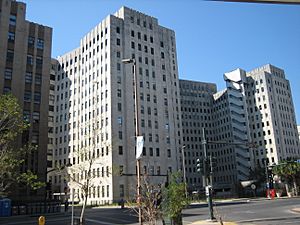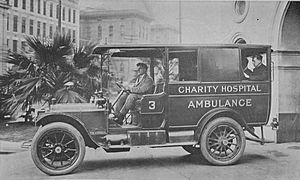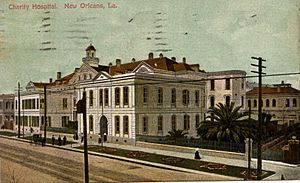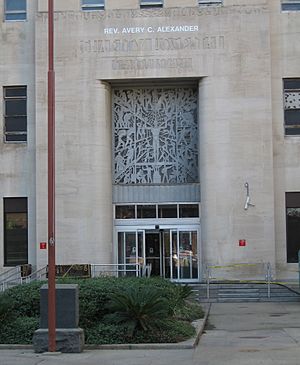Charity Hospital (New Orleans) facts for kids
Quick facts for kids Charity Hospital |
|
|---|---|

Charity Hospital Building
|
|
| Geography | |
| Location | 1532 Tulane Ave., New Orleans, Louisiana, United States |
| Coordinates | 29°57′19″N 90°04′41″W / 29.9554°N 90.0780°W |
| Organization | |
| Funding | Public hospital |
| Hospital type | General, Teaching Hospital |
| Affiliated university | Louisiana State University School of Medicine, Tulane University School of Medicine |
| Services | |
| Beds | 2,680 |
| History | |
| Founded | May 10, 1736 |
| Closed | August 2005 |
Charity Hospital was a very important teaching hospital in New Orleans. It was a big part of the Medical Center of Louisiana. After Hurricane Katrina hit in 2005, the hospital closed. The state decided not to reopen it in its original spot. Instead, a new hospital was built. This new hospital, called University Medical Center New Orleans, opened in 2015. It took over the important work Charity Hospital used to do.
Contents
About Charity Hospital
Charity Hospital was one of several public hospitals in Louisiana. The Louisiana State University System managed these hospitals. Charity Hospital and University Hospital were both teaching hospitals. This means they helped train new doctors. They worked closely with the LSU Health Sciences Center in New Orleans.
Before Hurricane Katrina, Charity Hospital was located at 1532 Tulane Avenue in New Orleans. It was in the city's main hospital area.
A Long History
Charity Hospital started on May 10, 1736. It was founded thanks to a gift from Jean Louis. He was a French sailor who wanted to help people. His will said his money should be used to build a hospital for poor people. This was in the new colony of New Orleans.
The first hospital was called the Hospital of Saint John. It was also known as L’Hôpital des Pauvres de la Charité. This means "The Charity Hospital for the Poor." It was built in what is now the French Quarter. New Orleans was founded in 1718. So, the hospital opened just 18 years later. It was the second oldest public hospital in the United States. Only Bellevue Hospital in New York City is older.
The hospital quickly became too small. A second hospital was built in 1743. A third one followed in 1785. This one was renamed the San Carlos Hospital. This honored King Charles III of Spain.
A fire destroyed this hospital in 1809. For a while, the hospital moved to temporary places. A fourth hospital was finished in 1815. It was built on Canal Street. But many people thought it was not good enough.
In 1832, a fifth hospital was built on Common Street. This street is now Tulane Avenue. In 1834, the Sisters of Charity started running the hospital. They managed it for the next 100 years. Charity Hospital also worked with the Medical College of the University of Louisiana.
In 1858, there was a serious yellow fever outbreak. Many people got sick. That year, 11,337 patients were admitted to the hospital. Sadly, 1,382 of them died from yellow fever.
By the 1900s, New Orleans was growing fast. More people needed medical care. So, a sixth hospital was built on Tulane Avenue in 1939. At that time, it was the second largest hospital in the United States. It had 2,680 beds.
The building was designed by Weiss, Dreyfous & Seiferth. They also designed the Louisiana State Capitol. The hospital building has cool stone carvings and a metal screen. These artworks are by an artist named Enrique Alférez.
The LSU Health Sciences Center was built next to Charity Hospital in 1931. This happened under Governor Huey Pierce Long. Charity Hospital helped many people who did not have health insurance. It also had a top-ranked trauma center. This meant it was very good at treating serious injuries.
In 1970, the Louisiana Department of Health took over Charity Hospital. Later, it was transferred to the LSU System in 1997.
Hurricane Katrina's Impact
Like its sister hospital, University Hospital, Charity Hospital was badly damaged. This happened during Hurricane Katrina. The news showed how patients had to be moved out of the flooded hospital. After the storm, a temporary clinic opened. It was called the Spirit of Charity. This clinic later moved to the New Orleans Centre building. In 2007, a renovated University Hospital started providing emergency care. Then, in 2015, the new University Medical Center New Orleans opened. It took over the roles of both Charity Hospital and University Hospital.
Why Charity Hospital Wasn't Rebuilt
Some groups wanted to rebuild the old Charity Hospital. They hired experts to check the building. These experts said the old building was strong. They also said it was a great design. They thought fixing it up would be the fastest way to bring back a teaching hospital. But the state decided to build a brand new medical center instead. This new center would combine the services of both Charity and University Hospitals.
Future Plans for the Site
There have been many ideas to fix up Charity Hospital. In 2019, LSU, which owns the building, approved a new plan. The plan is to turn the old hospital into a mix of homes, shops, and other spaces. This project is important for New Orleans. It will help bring new life to the area.
A group called 1532 Tulane Partners is leading the project. Work was expected to start in late 2019. It should take about three years to finish. The project will cost around $300 million. It will include about 390 homes. There will also be shops and restaurants. Tulane University will use parts of the building for student housing and offices.
Charity Hospital in Media
Charity Hospital has been shown in different TV shows and movies.
Television
- The TLC show Code Blue featured Charity Hospital. It showed the lives of doctors and patients. The episodes often highlighted how many patients came in with serious injuries.
- Charity Hospital was also in two episodes of TLC's Trauma: Life in the ER. These episodes focused on its emergency department.
- It also appeared in an episode of NY Med. A doctor on the show remembered his time working there.
Film
- Big Charity is a documentary film by Alexander John Glustrom. It tells the story of why Charity Hospital closed.
Books
Non-fiction
- Salvaggio, John E. wrote New Orleans' Charity Hospital (1992).
- Jim Carrier's book, Charity – The Heroic and Heartbreaking Story of Charity Hospital in Hurricane Katrina (2015), tells about the hospital's last days.
Fiction
- In the 2015 novel Elemental Arcane by Phaedra Weldon, Charity Hospital is mentioned.
- In Dolores Redondo's novel La Cara Norte del Corazón (2019), Charity Hospital appears during Hurricane Katrina.
Images for kids






